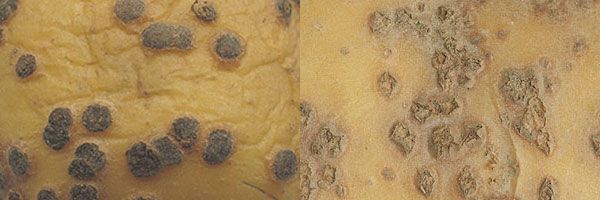
Spongospora subterranea
(Powdery scab)
- Causal agent and transmission
Powdery scab is caused by a soil-borne obligate fungus, Spongospora subterranea, which forms superficial lesions on the tuber surface and galls on roots and stolons of susceptible potato cultivars.
This pathogen is also the vector of the Potato mop-top virus (PMTV) which causes external and internal necrosis of the tuber, known as spraing.
It can survive for a very long time in the soil. It constitutes a major source of inoculum.
Infected tubers also contribute to the spread of the disease into healthy areas. Moreover, due to the capacity of the contaminating spores to be dispersed in the wind like powder, any farm equipment or organic substrates (manure, soil substrate etc), as well as soil or dust storms can carry contaminating spores and transmit both the fungal vector and its virus.
Until now, tomato and potato crops are the only known hosts of this fungus.
- Significance
This disease may occur worldwide wherever the potato is grown. It thrives best in cool climates. When significantly established in a field, and when the climatic conditions have been optimal (cold and humid on emergence), powdery scab attack can lead to a complete yield loss in the case of the crop of a susceptible cultivar.
Moreover, being the vector of the Potato mop top virus makes powdery scab a very serious threat to any potato production.





